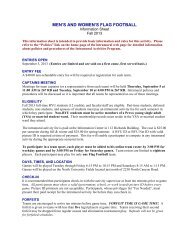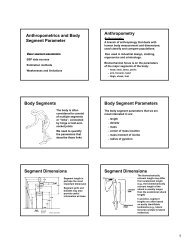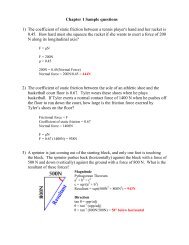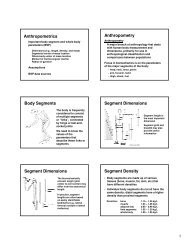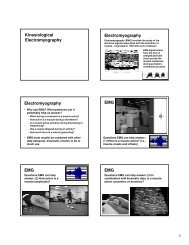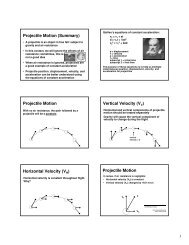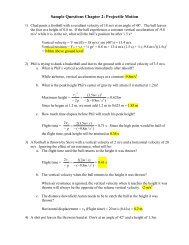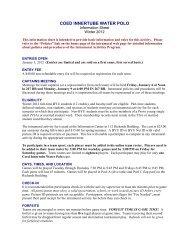Section 1 (Answers could very) 1. The purpose of the study was to ...
Section 1 (Answers could very) 1. The purpose of the study was to ...
Section 1 (Answers could very) 1. The purpose of the study was to ...
You also want an ePaper? Increase the reach of your titles
YUMPU automatically turns print PDFs into web optimized ePapers that Google loves.
<strong>Section</strong> 1<br />
(<strong>Answers</strong> <strong>could</strong> <strong>very</strong>)<br />
<strong>1.</strong> <strong>The</strong> <strong>purpose</strong> <strong>of</strong> <strong>the</strong> <strong>study</strong> <strong>was</strong> <strong>to</strong> examine reaction forces transmitted <strong>to</strong> <strong>the</strong> upper extremities<br />
<strong>of</strong> high-level gymnasts during <strong>the</strong> round-<strong>of</strong>f phase <strong>of</strong> <strong>the</strong> Yurchenko vault.<br />
2. <strong>The</strong> two conditions were whe<strong>the</strong>r <strong>the</strong> elite-gymnast performed a Yurchenko vault, or a floor<br />
exercise pass.<br />
3. <strong>The</strong> two dependent variables were <strong>the</strong> peak vertical and anterior-posterior reaction forces.<br />
4. High reaction forces transmitted <strong>to</strong> <strong>the</strong> upper-extremities are more dangerous than high<br />
reaction forces transmitted <strong>to</strong> <strong>the</strong> lower-extremities because <strong>the</strong> lower-extremities are designed<br />
for such weight bearing activities: <strong>the</strong> upper-extremities only involve relatively small bones <strong>of</strong><br />
<strong>the</strong> hand, wrist, and arm, with little cushioning; also <strong>the</strong> upper-extremities have less muscle<br />
mass, relative <strong>to</strong> <strong>the</strong> lower-extremities.<br />
<strong>Section</strong> 2<br />
A. A golfer hits her tee-shot due north <strong>to</strong>wards <strong>the</strong> fairway. Her shot has an initial velocity <strong>of</strong> 60<br />
m/s. A 15 m/s wind is blowing in a northwesterly direction (45 degrees west <strong>of</strong> North).<br />
<strong>1.</strong> Considering <strong>the</strong> initial velocity <strong>of</strong> <strong>the</strong> ball and <strong>the</strong> velocity <strong>of</strong> wind, what will be <strong>the</strong><br />
resultant velocity (m/s) <strong>of</strong> <strong>the</strong> golf ball assuming no o<strong>the</strong>r forces are acting on <strong>the</strong> ball?<br />
First, draw a picture and combine <strong>the</strong> two velocity vec<strong>to</strong>rs using <strong>the</strong> tip <strong>to</strong> tail method.<br />
15 m/s<br />
Resultant<br />
velocity<br />
60 m/s<br />
Next, resolve <strong>the</strong> 15 m/s velocity vec<strong>to</strong>r in<strong>to</strong> vertical and horizontal components using sin and cosine.<br />
Sin(45)*15 = 10.6<br />
10.6<br />
15 m/s<br />
Cos(45)*15 = 10.6<br />
10.6<br />
Now, add <strong>the</strong> two vertical components <strong>to</strong>ge<strong>the</strong>r (10.6 and 60) and combine <strong>the</strong> new vertical vec<strong>to</strong>r<br />
(70.6) with <strong>the</strong> resolved horizontal vec<strong>to</strong>r (10.6) using <strong>the</strong> tip <strong>to</strong> tail method.<br />
10.6<br />
Resultant<br />
velocity<br />
70.6 m/s
Next use Pythagoreans equation <strong>to</strong> solve for <strong>the</strong> resultant velocity<br />
c = 7<strong>1.</strong>4 m/s<br />
2. What will be <strong>the</strong> resultant direction (º west <strong>of</strong> North) <strong>of</strong> <strong>the</strong> golf ball?<br />
Use inverse tangent <strong>to</strong> solve for <strong>the</strong> resultant direction (angle).<br />
tan -1 (10.6/70.) = 8.54 ° West <strong>of</strong> North<br />
B. An 80-kg firefighter slides down a fire pole. After <strong>1.</strong>3 seconds <strong>of</strong> sliding, <strong>the</strong> firefighter is<br />
sliding at a velocity <strong>of</strong> 6.5 m/s, straight down <strong>the</strong> pole. <strong>The</strong> firefighter <strong>the</strong>n grips <strong>the</strong> pole tighter<br />
so that <strong>the</strong> force <strong>of</strong> friction exerted by <strong>the</strong> firefighter's hands on <strong>the</strong> pole is equal <strong>to</strong> <strong>the</strong> force <strong>of</strong><br />
gravity.<br />
<strong>1.</strong> At this point (remembering New<strong>to</strong>n's Second Law), when <strong>the</strong> friction and gravitation<br />
forces are equal, what is <strong>the</strong> downward acceleration <strong>of</strong> <strong>the</strong> firefighter?<br />
No calculations are need here. New<strong>to</strong>n’s Second Law states that ∑F = m·a. So if <strong>the</strong> two vertical<br />
forces are equal and opposite, <strong>the</strong> sum <strong>of</strong> <strong>the</strong> forces is equal <strong>to</strong> zero. <strong>The</strong>refore, <strong>the</strong> acceleration<br />
is also zero.<br />
2. Knowing that acceleration indicates a change in velocity, if <strong>the</strong> firefighter continues <strong>to</strong><br />
hold his same grip, maintaining <strong>the</strong> same friction force, for ano<strong>the</strong>r second what will be<br />
his velocity?<br />
If <strong>the</strong> acceleration is equal <strong>to</strong> zero, that would indicate <strong>the</strong>re is no change in velocity. If <strong>the</strong>re is<br />
no change in velocity over time, <strong>the</strong> velocity <strong>of</strong> <strong>the</strong> firefighter would be <strong>the</strong> same as it <strong>was</strong><br />
previous. <strong>The</strong>refore, <strong>the</strong> velocity remains <strong>to</strong> be 6.5 m/s.




